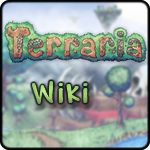m (Various fixes) |
(found in underground layer as well) |
||
| (42 intermediate revisions by 23 users not shown) | |||
| Line 1: | Line 1: | ||
{{item infobox |
{{item infobox |
||
| − | | type = |
+ | | type = Furniture |
| − | | |
+ | | width = 1 | height = 2 |
| − | | |
+ | | auto = 1114 |
| − | | |
+ | | tags = plunder |
| − | | height = 2 |
||
| − | | stack = 99 |
||
| − | | tooltip = Used to make Orange Dye |
||
| − | | consumable = True |
||
| − | | rare = 1 |
||
| − | | use = 14 |
||
| − | | tool = Pickaxe |
||
| − | | sell = {{sc|20}} |
||
| − | | id = 1114 |
||
| − | | idtile = 227 (8) |
||
}} |
}} |
||
| − | The '''Orange Bloodroot''' is a [[Dye#Basic Dyes|dye material]] that grows from dirt ceilings in the [[ |
+ | The '''Orange Bloodroot''' is a [[Dye#Basic Dyes|dye material]] that grows from [[Dirt Block|dirt]] ceilings in the [[underground]] and [[cavern]] layers. It can be harvested with a [[pickaxe]] or [[drill]]. Its sole purpose is to make [[Orange Dye]]. |
== Crafting == |
== Crafting == |
||
| − | {{exclusive|desktop=y|console=y|mobile=y|section=y}} |
||
| − | |||
=== Used in === |
=== Used in === |
||
| + | {{recipes|ingredient=Orange Bloodroot|expectedrows=2}} |
||
| − | {{crafts top}} |
||
| − | {{crafts row | top=y |
||
| − | | tool = Dye Vat | toolspan = 1 |
||
| − | | result = Orange Dye | |
||
| − | | Orange Bloodroot | |
||
| − | }} |
||
| − | {{crafts bottom}} |
||
== Notes == |
== Notes == |
||
| ⚫ | |||
| ⚫ | |||
| + | * The Orange Bloodroot is extremely rare to find. Even though the places it can spawn are common, its spawn rate is exceptionally low. It is one of the rarest naturally occurring ingredients for a dye. |
||
| ⚫ | |||
| + | |||
| ⚫ | |||
| + | == Tips == |
||
| ⚫ | |||
| ⚫ | |||
| + | * Players can use a [[Spelunker Potion]] to highlight Orange Bloodroot, making it much easier to locate. |
||
| ⚫ | |||
| + | * In the {{old-gen console version}}, Orange Bloodroots appear to spawn much less frequently. |
||
| + | |||
| + | == Trivia == |
||
| ⚫ | |||
== Gallery == |
== Gallery == |
||
| + | <gallery widths="200px" heights="200px"> |
||
| − | [[File:Blood Root on Map.png|none|thumb|150x150px|Red Circle is where the Orange Blood Root is located]] [[File:Orange Bloodroot in cave.png|none|thumb|242x242px|The respective Orange Bloodroot on map above]] |
||
| + | File:Blood Root on Map.png|The red circle is the Orange Bloodroot's location. |
||
| + | File:Orange Bloodroot in cave.png|The same Orange Bloodroot in the regular game view. |
||
| + | </gallery> |
||
== History == |
== History == |
||
| − | {{history |
+ | {{history|Desktop 1.4.0.1| |
| + | ** Sprite updated. |
||
| + | ** Now produces 2 [[Orange Dye]]s instead of 1.}} |
||
| + | {{history|Desktop 1.2|Introduced.}} |
||
| + | {{history|Console 1.02|Introduced.}} |
||
| + | {{history|Switch 1.0.711.6|Introduced.}} |
||
| + | {{history|Mobile 1.2.6508|Introduced.}} |
||
| + | {{history|3DS-Release|Introduced tile, but not associated item.}} |
||
| + | |||
| + | {{Dye Materials}} |
||
{{Master Template Consumables |
{{Master Template Consumables |
||
| Line 46: | Line 47: | ||
}} |
}} |
||
| + | [[fr:Racine sanglante orange]] |
||
| ⚫ | |||
| + | [[ko:주황색 혈근초]] |
||
| + | [[zh:橙血根草]] |
||
| ⚫ | |||
Revision as of 16:47, 30 October 2020
Orange Bloodroot
The Orange Bloodroot is a dye material that grows from dirt ceilings in the underground and cavern layers. It can be harvested with a pickaxe or drill. Its sole purpose is to make Orange Dye.
Crafting
Used in
| Result | Ingredients | Crafting station |
|---|---|---|
Notes
- Orange Bloodroot can be seen on the map as a red dot. It can be easily mistaken for dripping lava or a Life Crystal.
- The Orange Bloodroot is extremely rare to find. Even though the places it can spawn are common, its spawn rate is exceptionally low. It is one of the rarest naturally occurring ingredients for a dye.
Tips
- Players might have more success finding Orange Bloodroot in the underground layer than in the caverns, as there is more dirt.
- Players can use a Spelunker Potion to highlight Orange Bloodroot, making it much easier to locate.
- Although Orange Bloodroot is available in placed form on the Nintendo
version, breaking one never yields an item.
- In the
 Old-gen console version, Orange Bloodroots appear to spawn much less frequently.
Old-gen console version, Orange Bloodroots appear to spawn much less frequently.
Trivia
- The name might make it sound like it is only found in the Crimson, however it can be found anywhere underground.
Gallery
History
- Desktop 1.4.0.1:
- Sprite updated.
- Now produces 2 Orange Dyes instead of 1.
- Desktop 1.2: Introduced.
- Console 1.02: Introduced.
- Switch 1.0.711.6: Introduced.
- Mobile 1.2.6508: Introduced.
- 3DS-Release: Introduced tile, but not associated item.


